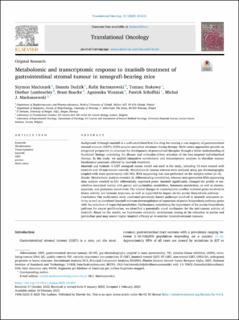| dc.contributor.author | Macioszek, Szymon | |
| dc.contributor.author | Dudzik, Danuta | |
| dc.contributor.author | Bartoszewski, Rafał | |
| dc.contributor.author | Stokowy, Tomasz | |
| dc.contributor.author | Lambrechts, Diether | |
| dc.contributor.author | Boeckx, Bram | |
| dc.contributor.author | Wozniak, Agnieszka | |
| dc.contributor.author | Schöffski, Patrick | |
| dc.contributor.author | Markuszewski, Michał J. | |
| dc.date.accessioned | 2023-07-04T11:16:30Z | |
| dc.date.available | 2023-07-04T11:16:30Z | |
| dc.date.created | 2023-06-02T14:50:56Z | |
| dc.date.issued | 2023 | |
| dc.identifier.issn | 1944-7124 | |
| dc.identifier.uri | https://hdl.handle.net/11250/3075538 | |
| dc.description.abstract | Background
Although imatinib is a well-established first-line drug for treating a vast majority of gastrointestinal stromal tumours (GIST), GISTs acquire secondary resistance during therapy. Multi-omics approaches provide an integrated perspective to empower the development of personalised therapies through a better understanding of functional biology underlying the disease and molecular-driven selection of the best-targeted individualised therapy. In this study, we applied integrative metabolomic and transcriptomic analyses to elucidate tumour biochemical processes affected by imatinib treatment.
Materials and methods
A GIST xenograft mouse model was used in the study, including 10 mice treated with imatinib and 10 non-treated controls. Metabolites in tumour extracts were analysed using gas chromatography coupled with mass spectrometry (GC-MS). RNA sequencing was also performed on the samples subset (n=6).
Results
Metabolomic analysis revealed 21 differentiating metabolites, whereas next-generation RNA sequencing data analysis resulted in 531 differentially expressed genes. Imatinib significantly changed the profile of metabolites associated mainly with purine and pyrimidine metabolism, butanoate metabolism, as well as alanine, aspartate, and glutamate metabolism. The related changes in transcriptomic profiles included genes involved in kinase activity and immune responses, as well as supported its impact on the purine biosynthesis pathway.
Conclusions
Our multi-omics study confirmed previously known pathways involved in imatinib anticancer activity as well as correlated imatinib-relevant downregulation of expression of purine biosynthesis pathway genes with the reduction of respectful metabolites. Furthermore, considering the importance of the purine biosynthesis pathway for cancer proliferation, we identified a potentially novel mechanism for the anti-tumour activity of imatinib. Based on the results, we hypothesise metabolic modulations aiming at the reduction in purine and pyrimidine pool may ensure higher imatinib efficacy or re-sensitise imatinib-resistant tumours. | en_US |
| dc.language.iso | eng | en_US |
| dc.publisher | Elsevier | en_US |
| dc.rights | Navngivelse 4.0 Internasjonal | * |
| dc.rights.uri | http://creativecommons.org/licenses/by/4.0/deed.no | * |
| dc.title | Metabolomic and transcriptomic response to imatinib treatment of gastrointestinal stromal tumour in xenograft-bearing mice | en_US |
| dc.type | Journal article | en_US |
| dc.type | Peer reviewed | en_US |
| dc.description.version | publishedVersion | en_US |
| dc.rights.holder | Copyright 2023 The Author(s) | en_US |
| dc.source.articlenumber | 101632 | en_US |
| cristin.ispublished | true | |
| cristin.fulltext | original | |
| cristin.qualitycode | 1 | |
| dc.identifier.doi | 10.1016/j.tranon.2023.101632 | |
| dc.identifier.cristin | 2151339 | |
| dc.source.journal | Translational Oncology | en_US |
| dc.identifier.citation | Translational Oncology. 2023, 30, 101632. | en_US |
| dc.source.volume | 30 | en_US |

